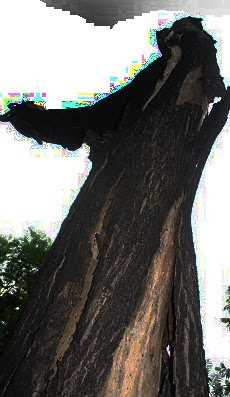Dr Abe V Rotor
Tamaraw in its natural habitat in Mindoro Island; skeleton of a tamaraw at the Museum of Natural History, UPLB Mt Makiling Laguna
The Tamaraw (Bubalus
mindorensis) or Mindoro Dwarf Buffalo is a small hoofed mammal belonging to
the family Bovidae. It is endemic to the island of Mindoro in the Philippines
and is the only endemic Philippine bovine. It is believed, however, to have
once also thrived on the greater island of Luzon. The tamaraw was originally
found all over Mindoro, from sea level up to the mountains (2000 meters above
sea level), but because of human habitation, hunting, and logging, it is now
restricted to only a few remote grassy plains and is now an endangered species.
Contrary to common
belief and past classification, the tamaraw is not a subspecies of the local
carabao, which is only slightly larger, or the common water buffalo. In
contrast to the carabao, it has a number of distinguishing characteristics: it
is slightly hairier, has light markings on its face, is not gregarious, and has
shorter horns that are somewhat V-shaped. It is the largest native terrestrial
mammal in the country.
To me this means that
the carabao and tamaraw, though of different lineages, undoubtedly had a common
ancestor, shared by other buffaloes found in Asia and in different parts of the
world.
In the same manner
plants and animal species evolved from common stocks, popularly referred to
as missing links, named for the fact that it is rare and
extremely difficult to determine where that crossroad of dichotomy lies.
When Charles Darwin
found out that finches vary from island to island in the Galapagos group pf
islands on the equatorial eastern coast of South America, he was in effect
telling to the scientific community of an evolutionary phenomenon called speciation -
the formation of species. Because it is a very slow and indeterminate at that,
scientists were baffled by the question, "When does a species called a
species, and not just a variety or breed?"
What I learned from my
professor, the famous Deogracias Villadolid who introduced tilapia in the
Philippines in the fifties, is that, when the species in question is capable of
interbreeding to make a population, and on the other hand, no longer capable of
breeding with its original stock or parent species, or members of its former
lineage. Dr Villadolid emphasized that this criterion is more reliable than
morphological deviation, ecological distribution notwithstanding.
The tamaraw is no doubt
a product of speciation. The island of Mindoro is its original home and still
its natural habitat today, the forested areas and near open-canopied glades.
Since human habitation and subsequent forest fragmentation its population has
drastically declined to a few dozens. This is exactly the same situation the wild
buffaloes of bisons of the Prairies face before they are saved from extinction
in the last hour.
The tamaraw is a grazer
that feeds on grasses and young bamboo shoots although it is known to prefer
cogon (Imperata cylindrica) and talahib (Saccharum spontaneum).
They are naturally diurnal, feeding during the daytime hours; however, daytime
human activities have recently forced select B. mindorensis individuals to be
nocturnal to avoid human contact.
The tamaraw is known to live for about 20 years, with an estimated lifespan of about 25. The adult female tamaraw gives birth to one offspring after a gestation period of about 300 days.There is an interbirth interval of two years, although one female has been sighted with three juveniles. The calf stays for 2–4 years with its mother before becoming independent.
Let's help conserve the highly endangered tamaraw, proudly our own endemically.
Credit: Museum of Natural History UPLB, Marlo Rotor for the photo. and Wikipedia
The tamaraw is known to live for about 20 years, with an estimated lifespan of about 25. The adult female tamaraw gives birth to one offspring after a gestation period of about 300 days.There is an interbirth interval of two years, although one female has been sighted with three juveniles. The calf stays for 2–4 years with its mother before becoming independent.
Let's help conserve the highly endangered tamaraw, proudly our own endemically.
Credit: Museum of Natural History UPLB, Marlo Rotor for the photo. and Wikipedia























.JPG)